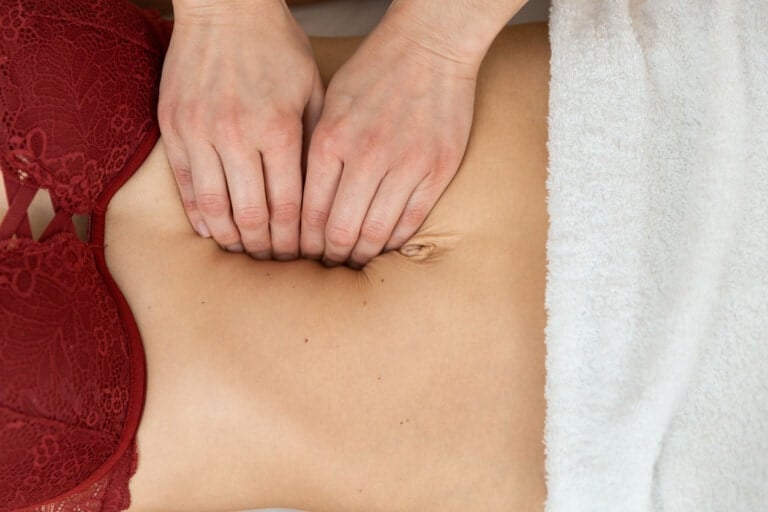Your pelvic floor is a thin layer of muscles that run from the pubic bone to the coccyx. The pelvic floor plays an important role in many things, like supporting your body’s internal organs (bladder, intestines, uterus, etc.), enabling you to maintain urinary and bowel control, and providing support vital for reproductive and sexual functioning.
Your pelvic floor supports your organs during activities that stress them physically, such as laughing, sneezing, and coughing, and also plays a vital role in supporting the spine.
Unfortunately, many moms are unaware of the importance of maintaining a healthy pelvic floor as a crucial part of your body’s internal core stabilizers. You can’t ignore your pelvic floor if you want to strengthen your core.
In addition, weak pelvic floor muscles cause serious issues for moms. Many moms think leaking urine while laughing, sneezing, or coughing is normal. This is NOT normal, and it’s a sign of a serious issue.
After pregnancy, weakened pelvic floor muscles often cause Urinary Stress Incontinence. Signs of this issue include the accidental release of urine while laughing, sneezing, or coughing. They can also contribute to uterine or bladder prolapse, a serious condition where one or both organs drop down and sag into the vaginal wall. Unless you adequately strengthen your pelvic floor muscles after childbirth, these problems will worsen with subsequent vaginal deliveries, weight gain, and aging.
Here are 4 things every mom must know about their pelvic floor:
1. STRETCH: Pregnancy Stretches Your Pelvic Floor
During pregnancy, your abdominal wall slowly expands over 9 months. But that’s not the only thing that stretches.
When it comes time to deliver, your pelvic floor muscles also have to stretch to make room for your baby. But their stretching isn’t done slowly over 9 months. They stretch and often tear in just a matter of hours as your body prepares for childbirth.
In many cases, pelvic muscles do not automatically rebound after childbirth. To prepare for delivery and help you recover faster, you need to strengthen them through kegel exercises, comprised of repeated contraction of your pelvic floor muscles, and other exercises like squats and bridges that engage your core and pelvic floor.
2. STRENGTHEN: You CAN Strengthen Your Pelvic Floor
Pelvic floor muscles are no different than any other muscle on your body. When your pelvic floor muscles are well conditioned, they have greater flexibility than they would if they were weak. Muscle weakness and atrophy decrease your pelvic floor flexibility just as any other muscle. If you fail to strengthen it, you greatly increase your risks for the abovementioned problems. It’s important for all pregnant or postpartum women to be consistent with strengthening through a program designed to prevent weakness and protect these important muscles. In addition to Kegel exercises, women should engage in strengthening that involves full-body movements to retrain these areas.
3. CONTRACT: Kegel Exercises Can Help After Childbirth
As mentioned above, you CAN strengthen your pelvic floor. Kegel exercises alone are generally not enough and should be combined with other exercises designed to strengthen the core and attached muscles. Kegel exercises are contraction exercises that can help increase blood flow to the pelvic floor and helping to speed healing after childbirth. The proper starting position for Kegel exercises includes any comfortable position isolating your pelvic floor muscles from the inner thigh and buttocks muscles. It’s best to avoid doing kegel exercises while crossing your thighs or standing, as this also engages the large muscles of the hips and thighs and does not isolate the pelvic floor. Try doing your kegel exercises while sitting, lying on your side, or lying on your back with your knees bent.
How to Perform Kegel Exercises Properly:
- Squeeze the anal sphincter (not your butt cheeks) as tightly as possible, then squeeze the vaginal sphincter as tightly as possible.
- Slowly increase the intensity of your squeeze. Imagine an elevator rising higher and higher as you intensify your effort.
- Hold the contraction as tightly as possible for five or six seconds – no more than 10 seconds.
- Completely relax your effort, allowing your muscles to soften.
- Rest and repeat 10 times.
For optimal recovery after childbirth, experts recommend performing 5 sets throughout the day.
4. CONNECT: Connection to Your Core Matters
As you perform your Kegels, you may notice that you feel your deep abdominal muscles contract simultaneously with your pelvic muscles. This is because they are so closely connected. During kegel exercises, you may notice your belly button move, your waist narrow, or your abdominal muscles tense. Your deep abdominals (transverse abdominis), pelvic floor muscles, and deep spinal muscles are all designed to work together to provide internal support and stability for your torso. That’s why core-conditioning programs that strengthen the pelvic floor simultaneously with the deep abdominals are such powerful core stabilization techniques.
If at any point through your workout you notice signs of core or pelvic weakness, STOP and modify until your workout can be completed without any of the following:
- If you are straining from within your abdomen or perineum during the exercise
- If you leak urine when doing any of the exercises
- If you notice pelvic or lower back pain during or after the exercise
- If you feel unstable in the core during the exercise
- If there is bulging or “coning” in your abdomen during the exercise
I know it can seem daunting, but staying on top of your pelvic floor health post-baby will make a difference in your overall health in the years to come.































